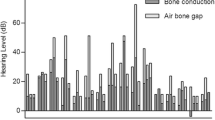Abstract
Surgical plugging and resurfacing are well established treatments of superior semicircular canal dehiscence, while capping with hydroxyapatite cement has been little discussed in literature. The aim of this study was to prove the efficacy of the capping technique. Charts of patients diagnosed with superior semicircular canal dehiscence were reviewed retrospectively. All patients answered the dizziness handicap inventory, a survey analyzing the impact of their symptoms on their quality of life. Capping of the dehiscent canal was performed via the middle fossa approach in all cases. Ten out of 22 patients diagnosed with superior semicircular canal dehiscence were treated with surgical capping, nine of which were included in this study. No major perioperative complications occurred. In 8 out of 9 (89 %) patients, capping led to a satisfying reduction of the main symptoms. One patient underwent revision surgery 1 year after the initial intervention. Scores in the dizziness handicap inventory were lower in the surgically treated group than in the non-surgically treated group, but results were not statistically significant (P = 0.45). Overall, capping is a safe and efficient alternative to plugging and resurfacing of superior semicircular canal dehiscence.


Similar content being viewed by others
References
Minor LB, Solomon D, Zinreich JS, Zee DS (1998) Sound- and/or pressure-induced vertigo due to bone dehiscence of the superior semicircular canal. Arch Otolaryngol Head Neck Surg 124:249–258
Minor LB (2005) Clinical manifestations of superior semicircular canal dehiscence. Laryngoscope 115:1717–1727
Rosowski JJ, Songer JE, Nakajima HH, Brinsko KM, Merchant SN (2004) Clinical, experimental, and theoretical investigations of the effect of superior semicircular canal dehiscence on hearing mechanisms. Otol Neurotol 25:323–332
Mikulec AA, McKenna MJ, Ramsey MJ, Rosowski JJ, Herrmann BS, Rauch SD, Curtin HD, Merchant SN (2004) Superior semicircular canal dehiscence presenting as conductive hearing loss without vertigo. Otol Neurotol 25:121–129
Minor LB, Carey JP, Cremer PD, Lustig LR, Streubel SO, Ruckenstein MJ (2003) Dehiscence of bone overlying the superior canal as a cause of apparent conductive hearing loss. Otol Neurotol 24:270–278
Takahashi N, Tsunoda A, Shirakura S, Kitamura K (2012) Anatomical feature of the middle cranial fossa in fetal periods: possible etiology of superior canal dehiscence syndrome. Acta Otolaryngol 132:385–390
Teixido M, Kung B, Rosowski JJ, Merchant SN (2012) Histopathology of the temporal bone in a case of superior canal dehiscence syndrome. Ann Otol Rhinol Laryngol 121:7–12
Nadgir RN, Ozonoff A, Devaiah AK, Haldermann AA, Sakai O (2011) Superior semicircular canal dehiscence: congenital or acquired condition? Am J Neuroradiol 32:947–949
Beyea JA, Agrawal SK, Parnes LS (2012) Transmastoid semicircular canal occlusion: a safe and highly effective treatment for benign paroxysmal positional vertigo and superior canal dehiscence. Laryngoscope 122:1862–1866
Amoodi HA, Makki MF, McNeil M, Bance M (2011) Transmastoid resurfacing of superior semicircular canal dehiscence. Laryngoscope 121:1117–1123
Crovetto M, Areitio E, Elexpuru J, Aguayo F (2008) Transmastoid approach for resurfacing of superior semicircular canal dehiscence. Auris Nasus Larynx 35:247–249
Hillman TA, Kertesz TR, Hadley K, Shelton C (2006) Reversible peripheral vestibulopathy: the treatment of superior canal dehiscence. Otolaryngol Head Neck Surg 134:431–436
Kurre A, van Gool CJ, Bastiaenen CH (2009) Translation, cross-cultural adaptation and reliability of the german version of the dizziness handicap inventory. Otol Neurotol 30:359–367
Andersson G, Lindvall N, Hursti T, Carlbring P (2002) Hypersensitivity to sound (hyperacusis): a prevalence study conducted via the internet and post. Int J Audiol 41:545–554
Sequeira SM, Whiting BR, Shimony JS (2011) Accuracy of computed tomography detection of superior canal dehiscence. Otol Neurotol 32:1500–1505
Tavassolie TS, Penninger RT, Zuñiga MG, Minor LB, Carey JP (2012) Multi-slice computed tomography in the diagnosis of superior canal dehiscence: how much error, and how to minimize it? Otol Neurotol 33:215–222
Penninger RT, Tavassolie TS, Carey JP (2011) Cone-beam volumetric tomography for applications in the temporal bone. Otol Neurotol 32:453–460
Bogle JM, Lundy LB, Zapala DA, Copenhaver A (2012) Dizziness handicap after cartilage cap occlusion for superior semicircular canal dehiscence. Otol Neurotol 34:135–140
Agrawal SK, Parnes LS (2007) Transmastoid superior semicircular canal occlusion. Otol Neurotol 29:363–367
Minor LB (2000) Superior canal dehiscence syndrome. Am J Otol 21:9–19
El Hadi T, Sorrentino T, Calmels MN, Fraysse B, Deguine O, Marx M (2012) Spontaneous tegmen defect and semicircular canal dehiscence: same etiopathogenic entity? Otol Neurotol 33:591–594
Vlastarakos PV, Proikas K, Tavoulari E, Kikidis D, Maragoudakis P, Nikolopoulos T (2009) Efficacy assessment and complications of surgical treatment of superior semicircular canal dehiscence: a meta-analysis of published interventional studies. Eur Arch Otorhinolaryngol 266:177–186
Limb CJ, Carey PJ, Srireddy S, Minor LB (2006) Auditory function in patients with surgically treated superior semicircular canal dehiscence. Otol Neurotol 27:969–980
Gilardino MS, Cabiling DS, Bartlett SP (2009) Long-term follow-up experience with carbonated calcium phosphate cement (Norian) for cranioplasty in children and adults. Plast Reconstr Surg 123:983–994
Verret DJ, Ducic Y, Oxforf L, Smith J (2005) Hydroxyapatite cement in craniofacial reconstruction. Otolaryngol Head Neck Surg 133:897–899
Mikulec AA, Poe DS, McKenna MJ (2005) Operative management of superior semicircular canal dehiscence. Laryngoscope 115:501–507
Conflict of interest
The authors declare that they have no conflict of interest.
Author information
Authors and Affiliations
Corresponding author
Rights and permissions
About this article
Cite this article
Mueller, S.A., Vibert, D., Haeusler, R. et al. Surgical capping of superior semicircular canal dehiscence. Eur Arch Otorhinolaryngol 271, 1369–1374 (2014). https://doi.org/10.1007/s00405-013-2533-x
Received:
Accepted:
Published:
Issue Date:
DOI: https://doi.org/10.1007/s00405-013-2533-x




